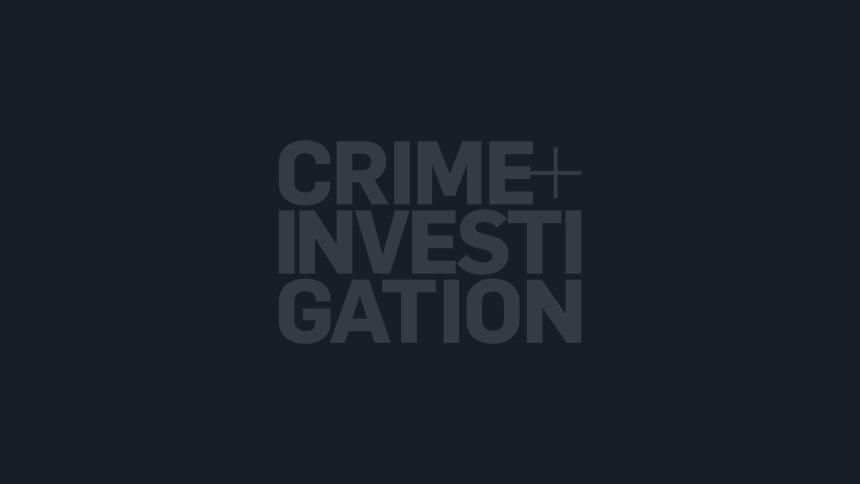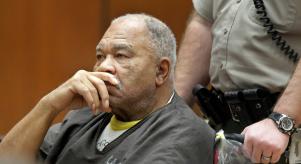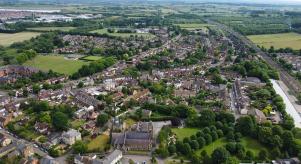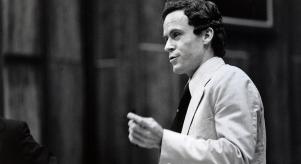
Freddie Mills: death of a sporting hero
Freddie Mills, World Champion Light Heavyweight boxer, family man and Soho night club owner was found dead in suspicious circumstances inside his car at the back of his nightclub in Goslett Yard on the 25th July, 1965. His body, slumped in the backseat of his silver Citroen had been mortally wounded by a single bullet to the right eye. A fairground rifle stood upright close by his legs. News of Mills’ mysterious death shocked the nation. Over 50 years later, what happened on that fateful night still remains a mystery.
A devoted family man who loved spending time with his children and family, Mills basked in the limelight of fame and the glittering baubles that came with it. However he never skimped on his private life as a family man who loved his two daughters, Susan (born 1952), Amanda (born 1958) and stepson Donnie McCorkindale from his wife Christine Marie McCorkindale’s former relationship.
'I can’t really remember as a child him without the camera in his hand' recalls Amanda. 'He would film everything! And thank god because now, all these years later, we can see Freddie whenever we like.' Mills’ eldest daughter Susan also recalls fond memories. 'He was a general all-round good guy. It’s unfortunate that his final day always takes up the story'
Born and raised in Bournemouth, Freddie Mills came from a poor background. As a youngster, he showed an interest in art but his older brother Charlie had been a successful boxer and Freddie seemed inspired to follow his footsteps. At 16 years old he began touring professionally in 1936. He learned his sparring trade by performing in fairground boxing booths such as ‘Sam McKeowen’s group’ where he would challenge local tough guys or anyone prepared to fight a professional. With McKeowen he toured around the west country. Very quickly he was winning five out of six bouts and gaining a reputation up until the beginning of WW2.
Besides being a much a loved family man to his young daughters and stepson Mills was a unique character in the world of boxing. Charismatic and erudite with a sophisticated voice more redolent of a 50’s BBC radio presenter Mills in many ways confounded the stereotypical view of a fighter. A genial, outgoing and confident performer he also possessed acting skills that were later put to use on both the silver screen and television. Mills had undeniable star quality that was quickly recognised by the world of show business.
So how can a man, so beloved and admired by millions, not just in Britain but all over the world, end up dead, shot in the back seat of his silver Citroen outside his own nightclub?
The turning point for Freddie Mills from national hero into global superstar was his second attempt to fight US Light-Heavyweight reigning champion Gus Lesnevich who was brought over to Britain by boxing promoter and manager Benny Huntman, who was to later play a crucial part in Mills’ career as a Soho club owner. The world televised fight took place at London’s White City stadium in July 1948. Mills was determined to take the crown from Lesnevich after their previous fight in 1946 when he was ill-prepared and lost. After that first brutal fight Mills admitted afterwards that he suffered chronic headaches and that he thought he had suffered a ‘mild brain haemorrhage’.
Despite concerns and doubts about Mills taking on Lesnevich a second time the match went ahead and saw Mills snatch victory from the American champ who graciously acknowledged the new British boxing phenomenon as his successor. Mills was set to defend his title against Lesnovich in September but the fight was cancelled due to Mills suffering severe headaches and dizziness. After losing his world champion status in 1949 and at just 30 years of age Freddie Mills retired from boxing and relinquished his British, European and Empire light-heavyweight titles.
The mid-1950s saw the start of a new career for Mills as he exploited his fame to appear on radio and later films and television. He was to become one of the first ‘celebrities’ feted by a press eager keen to keep the country’s most popular sportsman in the public eye. His fame was such that during the Queen’s coronation in 1953, Prince Philip was heard to say to his newly crowned wife, while observing crowds in The Mall, ‘Look, there’s Freddie Mills!’ confirming how the boy from Bournemouth had become a face even recognisable to royalty.
Having left his professional boxing days behind him Mills continued to venture into business (he had previously acquired property in the ’40s) with the opening of a Chinese Restaurant at 143 Charing Cross which after an unsuccessful run was turned into The Freddie Mills ‘Night Spot’ club in Soho. Stepson Donnie McCorkindale recalls how it was like ‘everybody’s idea of what a night-club should look like with banquettes and red velvet’.
Mills invited some of London’s top acts to perform on the opening night and the glitzy occasion also included characters from the world of crime, such as the Kray brothers. But by 1965 the dazzling spotlight of fame was beginning to dim on Freddie. As television work dried up he found the press less interested in him. Increasing bouts of depression may have been compounded by the fact that keeping his Soho club in the black was becoming more of a problem with huge debts stacking up. In an attempt to stave off bankruptcy Mills sold off properties and tried to sell the ailing nightclub. Were financial pressures and mounting debts the reason Mills killed himself outside his club, as was suggested by the police? Or could it be Mills’ association with the underworld led to a very different kind of end for him?
Soho in the mid ’60s was far from the sophisticated playground of expensive restaurants and trendy members clubs of today. Fifty years ago it was a breeding ground for prostitution and racketeering. Criminal gangs went about their business with impunity, largely due to corrupt elements of the local police-force happy to take bribes and look the other way.
Prof Brian J Ford, a scientist and forensic Investigator was undertaking independent academic research and had doubts about the suicide verdict.
To this day the case had puzzled me
'I was sent the bare facts of the case as a lot of people thought Freddie had been murdered. In the role of an ‘outsider’ I was asked to present an objective view of what the evidence suggested. To this day the case had puzzled me.' Ford established that Mills did borrow the fairground rifle from a friend, which was found by his slumped body and that he was prone to bouts of depression, possibly brought on through his years of boxing in the ring. These scant facts seemed to convince the police at the time that Mills had decided to take his own life in a pre-meditated fashion, even if he hadn’t left a note or indicated to friends and family members that he was struggling to cope with life. The coroner concluded that he committed suicide. Curiously, everyone who knew Freddie Mills believed that he was not the kind of man to kill himself. Mills’ wife Christine was stunned and angered by the verdict. In a witness statement, she said. ‘At no time whatsoever has my husband ever threatened to take his own life, neither has he left any letter or note at home which could possibly lead anyone to think he might do this.’
Prof Ford believes several facts that weren’t released during the initial investigation point to a verdict of suicide being improbable. One curious fact was that the World Champion boxer was found slumped in the back of his car with a gunshot to the right eye. It was recognised as highly unusual for a self-inflicted wound. Prof David Wingate, Resident Medical Officer at London’s Middlesex Hospital (1965-68) recalls the moment when the former boxer’s body was brought into hospital. ‘I noticed that because Mills had not being shot through his eyelid it meant that his eye was open when he was shot'. Prof Wingate put forward the argument that anyone wanting to commit suicide by looking down the muzzle of a gun would instinctively close their eyes the moment they squeezed the trigger. 'So I think he (Mills) was looking down the barrel of a gun, but somebody else was holding it'
Murder was a much more obvious conclusion
Ford himself testifies in the BBC4 documentary ‘Murder In Soho: Who Shot Freddie Mills?’ to not coming across any case where it was suggested that someone shot themselves with their eyes wide open. 'When people commit suicide there are two ways in which they shoot themselves, either through the forehead or else up through the mouth. But somebody threatening someone will often aim at the eye because the eye is what you’re looking at. It seemed to me that murder was a much more obvious conclusion that suicide' Contributing to a list of either unanswered examples of a lack of thoroughness with the case is the fact that Prof Wingate who examined Freddie’s dead body never appeared at the coroner’s inquest or was called to give evidence. Wingate recalls the reasons for this omission vividly in the BBC documentary. 'I think that the police didn’t want any fuss. I very much got that impression.'
One popular theory which persists today is that Freddie Mills had been killed by gangsters because the former Champion boxer turned Soho club owner wouldn’t pay protection money. Such an ‘arrangement’ between legit businesses and the underworld was an accepted part of life in Soho where a culture of backhanders to corrupt police continued until the mid ’70s. Freddie Mills ‘Nite Spot’ happened to be right in the middle of one of the most potent areas of criminality where the West End of London had more crime per square mile than anywhere else in Britain. The flashing neon lights of clubs and bars mingled with revellers in Italian coffee bars and pubs, was a lucrative playground for opportunists eager to have a slice of the rich takings of venues. Could it be that Mills was a victim of a criminal gang linked to protection money racketeering and if so, why didn’t they advertise the deed as a means to deter other non-payers?
Shortly after news of Freddie’s death anonymous ‘tips’ and letters were being received by the police saying that they knew who killed him. Some of the letters alluded to the West End protection racket theory where it was well known that owners of businesses who wouldn’t pay found themselves in trouble. Such shady dealings and corruption took place on a weekly basis while the police, often on the criminals’ payroll, looked the other way. One senior policeman who looked the other way was Detective Chief Inspector Wally Virgo, one of the investigating officers into Soho’s protection racket activities and who himself received twelve years in prison, overturned on appeal, for corruption. Was Inspector Virgo, along with other corrupt officers, involved in investigations into Freddie Mills’ death which if reported as murder could have led to uncomfortable questions about police activities at the time? The police reports typed up shortly after Mills’ body had been taken to Middlesex hospital state ‘He was found in a car with a rifle. I am almost certain it will resolve itself as suicide’.
One unorthodox activity that occurred when Freddie Mills’ body was found in such suspicious circumstances is that it was taken directly to hospital without the police having been informed first. Even though it appeared that Mills was dead, he was removed by ambulance resulting in the police never seeing Mills’ dead body in situ. There was no opportunity for the police or forensics to examine the circumstances and the way the body was found. Such a failing with standard practices has encouraged rumours for the past fifty years. As the police failed to examine the death scene at Goslett Yard, any important and incriminating forensic evidence was lost or even contaminated. As no CCTV surveillance existed at the time it could never be established who else may have also been in the yard waiting for Mills. Taking into account that Freddie Mills owed substantial amounts of money and may have refused to play the protection racket game some people like Prof Ford believe it is plausible that someone hired an assassin to kill him. Ford outlined a potential scenario where the mystery killer approaches Mills’ car with the fairground rifle after an arrangement had been made to meet Mills at his club.
24th July, 1965. Freddie Mills arrives at his Soho club in his Citroen car, pulling into Goslett Yard at 10.30pm. Mills is already in the back seat of his car due to his regular naps, or after waking decides to stay in the back seat in anticipation of an arranged meeting with an unidentified person or persons.
Moments later a stranger approaches with the fairground rifle and opens the back door on the driver’s side of the Citroen. A struggle takes place between Mills and the killer, with the gun firing and making a hole in the bottom side of the vehicle. Quickly the killer aims the gun at Mills’ face and shoots, blowing out his right eye. The gun is then placed neatly by Mills’ slumped body as if to infer that the former boxer, known to be in debt and suffering bouts of depression, committed suicide.
Taking into account that Mills was known to have borrowed the 0.22 calibre fairground rifle from a friend, May Ronaldson, who ran a shooting gallery, it is conceivable that he had the rife for protection and as security on the night of his death. The killer approaches the Citroen, in lieu of an arranged business meeting possibly relating to money. A violent struggle ensues when the meeting doesn’t go to plan resulting in the stranger shooting Mills in the face and then leaving the rifle by his side to look like a suicide.
Whatever the truth of that night, one certainty is that the Mills family were the first to see his body. At 12.45am, stepson Donnie and his wife along with Freddie’s wife Christine arrive at the scene after having set off from their home. According to Donnie in the BBC documentary he spots Freddie’s car and can see his stepfather sat in the back passenger seat. Donnie opens the door and pats Freddie on the knee telling to get out. There is no response. Donnie notices a goblet of blood congealed in Freddie’s right eye. He realises he is dead.
Freddie Mills was known to associate with members of the underworld which wasn’t unusual for a Soho club owner in the 60’s and where the world of boxing segued into the world of nightclubs and gambling with regularity. Whether Mills was blackmailed by members of the criminal world or threatened to pay protection money is still speculation. But one astonishing lead to a probable answer of one of the most mystifying deaths in post war Britain of a celebrity occurred in 2018 when a figure from Mills’ past re-surfaced fifty years after his death.
Roger Huntman, the elderly son of the one-time influential boxing promoter, manager and later casino owner Benny Huntman had a compelling story to tell, now that he knew he was no longer in danger of reprisals for talking. According to the contrite witness, Mills and Huntman became close friends after his promoter father had brought US reigning champion Gus Lesnevich to fight Mills in 1948. Huntman was ruthlessly ambitious and known to fraternise and do business with the ‘Mob’ across the pond. One of his main contacts with the Mafia was the notorious gangster Meyer Lansky, known as the Mob’s Accountant and a major ‘organised crime’ figure in America associated with a gambling empire across the world.
In a filmed meeting between Roger Huntman and Mills’ stepson Donnie McCorkindale a moment of desperation on Mills’ part put his father in a difficult situation. The Mafia associate Lanksy had big plans for turning the West End into Britain’s Las Vegas and he chose Benny Huntman (Roger’s father) to be his inside man in London. All these plans were threatened by an unexpected appearance by Mills at Benny Huntman’s flat days shortly before his death. 'My father was the link to the Mafia in America. All was going well until Freddie Mills turned up'
Now 75 and suffering from diabetes Roger Huntman describes the fatal moment when Mills may have signed his own death warrant. 'Freddie made a bet and laid his life down because of that bet. Big mistake, big mistake.'
The chilling account reads like a gangster-thriller script. 'Freddie arrived at my father’s flat at 2pm. He said "I’m skint and I need two and a half grand otherwise I’m going under” It then appears that when Benny Huntman pondered over the request Mills responded with a threat. 'I know who the people are you associate with. I’ll go to Fleet Street'.
It was this threat to go the press which according to Huntman’s son led to an agonised decision by his father to arrange an assassination. That ‘hit’ was carried out on Lansky’s orders. 'Freddie didn’t think of the consequences and the police afterwards didn’t want to know. There would have been an investigation that might unearth corruption and they didn’t want that.'
Having agreed to deliver the money that in Mills’ mind would save him, the reality was that an assassination was arranged between Benny Huntman and Meyer Lansky. A decision that according to son Roger, would haunt his father for the rest of his short life.
Whether these startling revelations are factual and draw a line under one of crime’s most mystifying deaths is still up for conjecture. The sad truth is that despite the incredible achievements of Freddie Mills, his phenomenal rise to superstardom from humble origins and becoming a World Champion boxer, his last day in a Soho back-alley is the one event in his life that due to its mysterious and sinister circumstances will always be remembered.




